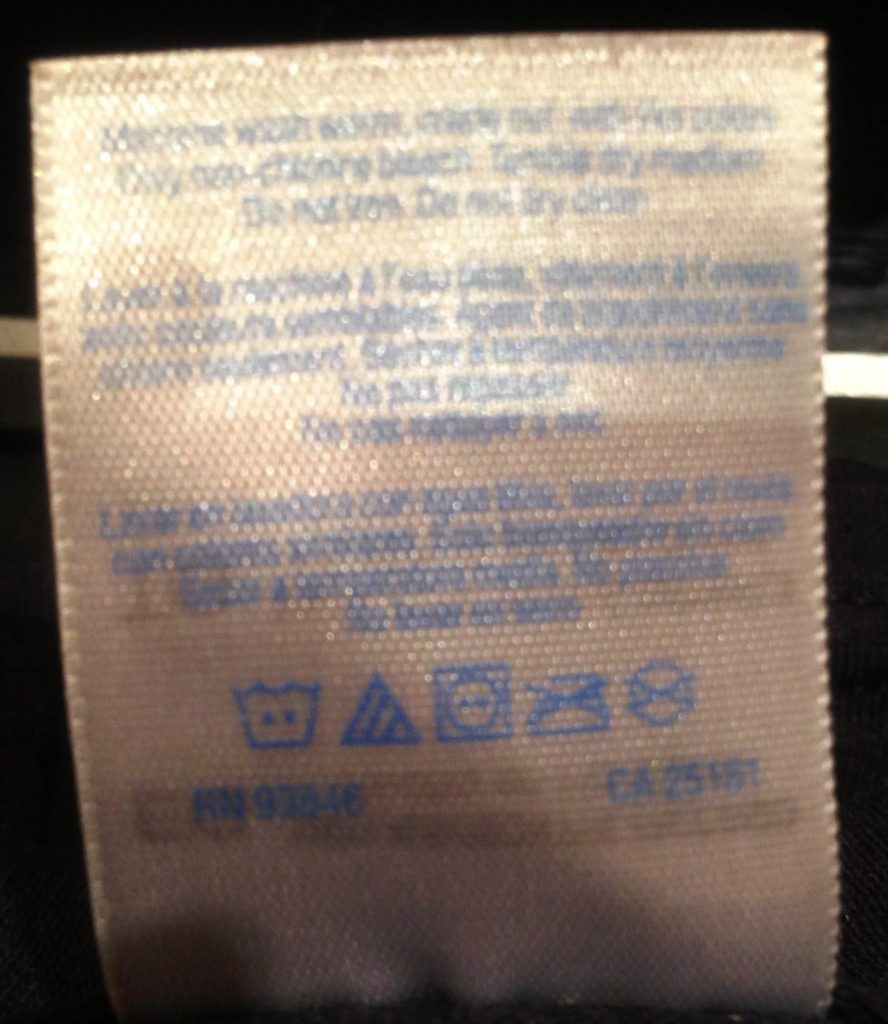Labels really are a part of our daily routine…
How many times during the course of a day do you read a label? Maybe you stop to read a food label to determine how many calories are in the product or the number of sodium milligrams or whether or not the product is stale dated or even recently recalled. You might stop to read the label on a cleaning product to see if there are any safety warnings that you should be aware of, like not combining a bleach product with a product that contains either ammonia or acid!
 |
| Machine wash warm, non-chlorine bleach when needed, tumble dry, normal, medium heat, do not iron, do not dryclean. |
Let’s not forget how many times while doing laundry we read the very tiny labels found in all of our clothing and household items like sheets and towels. Look at the label to the right. It is from a t-shirt. Its actual size is 1.25 X 1.25 inches. In the caption you can see what those universal care symbols represent. (You can click on the photo to enlarge the label).
Would you know what the universal care symbols represented? Do you often look at these symbols and just guess what they are trying to tell you? How many clothing items have you ruined with the laundering process simply because you forgot to read the label or couldn’t understand the label?
Now consider prescription drug labels…
This week the U.S. Food and Drug Administration (FDA) issued a news release announcing new safety labeling changes and postmarket study requirement for extended-release opioid analgesics. According to the FDA Commissioner, Margaret A. Hamburg, M.D.:
“The FDA is invoking its authority to require safety labeling changes and postmarket studies to combat the crisis of misuse, abuse, addiction, overdose, and death from these potent drugs that have harmed too many patients and devastated too many families and communities. Today’s action demonstrates the FDA’s resolve to reduce the serious risks of long-acting and extended release opioids while still seeking to preserve appropriate access for those patients who rely on these medications to manage their pain.”
Some highlights of the new labeling requirements
- Given the serious risks of using ER/LA opioids, the class-wide labeling changes, when final, will include important new language to help health care professionals tailor their prescribing decisions based on a patient’s individual needs.
- The updated indication states that ER/LA opioids are indicated for the management of pain severe enough to require daily, around-the-clock, long-term opioid treatment and for which alternative treatment options are inadequate.
- The updated indication further clarifies that, because of the risks of addiction, abuse, and misuse, even at recommended doses, and because of the greater risks of overdose and death, these drugs should be reserved for use in patients for whom alternative treatment options (e.g., non-opioid analgesics or immediate-release opioids) are ineffective, not tolerated, or would be otherwise inadequate to provide sufficient management of pain; ER/LA opioid analgesics are not indicated for as-needed pain relief.
- Recognizing that more information is needed to assess the serious risks associated with long-term use of ER/LA opioids, the FDA is requiring the drug companies that make these products to conduct further studies and clinical trials. The goals of these postmarket requirements are to further assess the known serious risks of misuse, abuse, increased sensitivity to pain (hyperalgesia), addiction, overdose, and death.
- The FDA is also requiring a new boxed warning on ER/LA opioid analgesics to caution that chronic maternal use of these products during pregnancy can result in neonatal opioid withdrawal syndrome (NOWS), which may be life-threatening and require management according to protocols developed by neonatology experts. NOWS can occur in a newborn exposed to opioid drugs while in the mother’s womb. Symptoms may include poor feeding, rapid breathing, trembling, and excessive or high-pitched crying.
- In addition, the FDA is notifying ER/LA opioid analgesic application holders of the need for changes to the following sections of drug labeling: Dosage and Administration; Warnings and Precautions; Drug Interactions; Use in Specific Populations; Patient Counseling Information, and the Medication Guide.
As consumers we often forget that the word label, as it pertains to any kind of prescription medicine, does not refer only to the label on the prescription bottle or vial, but also to the prescribing information, package insert, professional labeling, direction circular and the package circular.
An informative video from Consumer Reports
In July 2012, Consumer Reports published a video that deals with how much the consumer knows or understands about prescription labeling. Consumer Reports asks: When you fill a prescription, how well do you understand the label, stickers and information sheets that come with the bottle? Make sure you know what to ask before you leave the pharmacy.
If you are having trouble viewing the video, you can see it here.
Some final thoughts…
Take the time to discuss your prescriptions with your prescribing physician. If your pharmacist offers to discuss your prescription (new or otherwise), then accept the counseling. If you are having trouble reading the prescription label, then ask another family member or friend to assist you. If you begin to suspect that you are becoming dependent upon your prescription opioids, call your physician and seek help.
Also, if you find you have any unused prescription medications, stay alert for neighborhood take-back days. For example, this weekend in the Tucson area, there will be a Dispose-A-Med event sponsored by the Pima County Sheriff’s Department, September 14, 2013, 10am-2pm, 2175 W. Ruthrauff Road, Tucson, AZ (in front of the Walmart Neighborhood Market.






